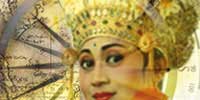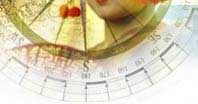|
Since there are so many other accounts of Balinese Hinduism available in guidebooks and other literature, we will spare you yet another one. Suffice to say, Balinese Hinduism permeates Ubud life as it has for eons. Some observers in fact, have noted a resurgence of religious activity, both in terms of outward devotional practice, and the more introspective, philosophical aspects of religiosity. Ubud is noted as one of the more traditional towns in terms of maintaining the tenets and manifold observances of Agama Hindu Bali. Everywhere you look, every single day, you will see ceremony, ritual and sacred offerings. All of this is carried out in Ubud with a level of devout attention and meticulous care that is rarely exceeded elsewhere. This applies equally to the young generation as it does to their parents and grandparents.
To witness (or participate in) the enactment of religious tradition, visit a temple during a holy day or on its anniversary, called and odalan. Your hotel, guest house, or the Balinese friends you make can tell you when and where an opportunity might arise. Consult the Bali Calendar to check dates of major festivals. You can't go more than a few metres in Ubud without seeing one hanging on someone's wall. Or let Balinese friends and acquaintances know you would be interested to attend a life-transition ritual (three-month birthday of a baby, tooth filing, wedding, cremation, etc.). Chances are, if you stay more than a few days you will have the opportunity to witness such an event.
The main temples in Ubud are the location for a tremendous variety of festivals, special prayers and observances of particular holy days. Following is a list of the some of the main temples and the dates of their odalans, beginning with the three main temples which are requisite to any Balinese desa. Before you attend any religious ceremony or enter a temple, read the "Etiquette and Dress Notice" in these web pages. Our advice is to find a Balinese friend or hotel employee who will take you to a ceremony, and advise you throughout about what is taking place, and how you can appreciate and participate in the ceremony without making a faux pas.
Visiting a Temple
Pura Desa Ubud. The main "town temple" in the centre, across from Ary's Warung.
Pura Puseh. The "temple of origin" devoted to Ubud's honoured ancestors. In Jalan Suweta.
Pura Dalem Ubud. The temple for the dark side of things. On the north side of Jalan Raya before the road descends to Campuan.
Pura Pamerajan Sari C. Agung. The private family temple of the Ubud royal family. On the east side of Jalan Suweta, a little north of the Palace.
Pura Taman Saraswati. Part of the Puri Saraswati complex, devoted to Dewi Saraswati the goddess of learning, literature and the arts, Features a fine padmasana (lotus throne). Beyond the lotus pond in the back of Cafe Lotus.
Pura Dalem Agung Padangtegal. Another temple for the dark side, down by the monkey forest.
Pura Gunung Lebah. At the confluence of the east and west branches of the Wos River, below the Campuan bridge.
Pura Batur Sari. A royal temple devoted to the deity of Mt Batur, ostensibly to spare the Ubud Tjokordas the long journey up to the mountain itself. During its odalan, the dance stage is set up in front of the temple, right in the middle of Jalan Suweta, a few hundred metres north of Ubud's main cross-roads.
History of Ubud
"Thank you for your support"
| 






